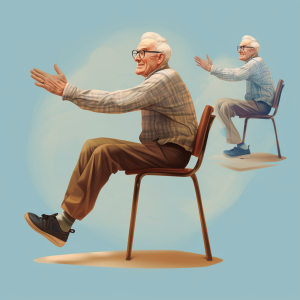Are you wondering why is a hip fracture so dangerous? Hip fractures can be compared to that treacherous iceberg that sunk the Titanic – seemingly simple on the surface, but with complexities and dangers lurking beneath. So, ever pondered, why exactly is a hip fracture so perilous? Let’s dive right in.
Contents
- 1 Anatomy of the Hip: More Than Just a Joint
- 2 The Domino Effect on Overall Health
- 3 Risk of Complications Post-Fracture
- 4 The Mental Toll of Immobility
- 5 Reduced Muscle Mass and Strength
- 6 Pneumonia: A Stealthy Foe
- 7 The Financial Burden
- 8 The Strain on Caregivers
- 9 The Long Road to Recovery
- 10 The Increased Risk of Mortality
- 11 Final Thoughts On Why Is A Hip Fracture So Dangerous?
- 12 FAQs
Anatomy of the Hip: More Than Just a Joint
The hip, often underappreciated, is a marvel of human anatomy. Much like the foundation of a skyscraper or the keystone of an arch, the hip plays a pivotal role in supporting our body’s framework. But what makes this joint so special? Let’s dig deeper.
The Basic Structure: Ball-and-Socket Design
If you’ve ever played with action figures or dolls, you’ve seen a ball-and-socket joint in action. The hip consists of the rounded head of the femur (ball) fitting into the acetabulum of the pelvis (socket). This design allows for a wide range of motion, letting us dance, jump, and do yoga poses!
Cartilage: The Shock Absorber
Imagine driving on a bumpy road without shock absorbers. Not pleasant, right? The cartilage in our hip functions similarly, cushioning the joint and ensuring smooth movement. This thin layer of smooth tissue helps protect the bones from friction and wear.
Ligaments: The Sturdy Cables
Ligaments are like the cables on a suspension bridge, connecting bone to bone. In the hip, several strong ligaments wrap around the joint, providing stability and preventing dislocation. They ensure that while the hip is mobile, it doesn’t wobble out of place with every move.
Muscles and Tendons: The Movers and Shakers
Surrounding the hip are multiple muscles, each with a specific role. The gluteals (your buttock muscles), hip flexors, and the inner thigh muscles all converge here. These muscles are attached to bones via tendons, ensuring that when a muscle contracts, the bone moves.
The Blood Supply: Nutrient Highways
The hip, like any major joint, has an intricate network of blood vessels. These ensure that vital nutrients reach the joint and waste products are efficiently removed. The femoral artery, one of the body’s major arteries, runs close to the hip, underlining the joint’s importance.
Synovial Fluid: Nature’s Lubricant
Within the hip joint is a special liquid called synovial fluid. Think of it as nature’s premium oil for our body’s machinery. This fluid ensures that the joint moves without any creaks or groans, lubricating and nourishing the cartilage.
The Domino Effect on Overall Health
Imagine setting up a long line of dominos, painstakingly ensuring each one stands perfectly. With just a slight nudge to the first piece, the entire line cascades down, each piece affecting the next. Such is the scenario with a hip fracture and its implications for overall health. The fracture might appear to be a single isolated event, but it can trigger a series of health-related consequences, much like those falling dominos.
Reduced Mobility: The First Domino
When a hip fractures, the immediate result is a significant reduction in mobility. Think of it as the first domino being tipped. This limitation means you’re less able to engage in physical activities, which in turn has cascading effects on multiple aspects of health.
Cardiovascular Health: The Heart Feels the Impact
With reduced mobility comes decreased cardiovascular exercise. Our hearts thrive on activity, and the lack thereof can contribute to decreased cardiovascular endurance, increased blood pressure, and even heightened risks for conditions like heart disease.
Weight Gain and Metabolic Changes
If you’re less active, you’re burning fewer calories. This can lead to weight gain, which comes with its own set of health challenges, from diabetes to increased strain on various body systems.
Bone Density: A Silent Casualty
Bones need to be stressed to remain strong, much like muscles. Reduced mobility means bones aren’t bearing as much weight, leading to a decrease in bone density. This raises the risk of future fractures – it’s like another line of dominos ready to topple.
Mental Health: Not Just a Physical Affair
Being less mobile can lead to feelings of isolation and depression. The mental and emotional toll can be profound, affecting mood, cognition, and overall well-being. Remember, the mind and body are interconnected dominos; when one falls, the other feels the impact.
Digestive System Woes
Reduced activity can lead to sluggish digestive systems. Constipation, bloating, and other gastrointestinal issues can become prominent, further affecting one’s quality of life.
Skin Health: Out of Sight, But Affected
Lack of movement, especially for prolonged periods, can result in pressure sores or ulcers, particularly in bedridden individuals. Our skin, the body’s largest organ, becomes another domino in the chain of health challenges.
Respiratory Complications
Remember the phrase “use it or lose it”? It applies to our lungs too. Decreased activity can lead to reduced lung capacity, making even simple activities feel strenuous and potentially leading to respiratory complications.
Risk of Complications Post-Fracture
Breaking a bone isn’t just about that painful moment of impact. Once a hip fracture occurs, a chain of events is set into motion, like a series of intricate gears turning within a clock. Some of these events, unfortunately, can be complications that can significantly impede recovery or even exacerbate overall health conditions.
Surgical Complications: The Immediate Aftermath
For many hip fractures, surgery becomes a necessity. However, as with any surgery, potential complications can arise:
- Infections: Even with modern sterile techniques, there’s always a risk of infection, whether it’s at the incision site or deeper within the joint.
- Blood Clots: Reduced mobility and surgical intervention can increase the risk of blood clots forming, especially in the legs. These clots can travel to the lungs, causing a life-threatening pulmonary embolism.
- Anesthesia Reactions: Every body is unique, and not everyone reacts the same way to anesthesia. Some might experience allergic reactions, while others could face respiratory or cardiovascular issues.
Postoperative Pneumonia: The Silent Threat
Bed rest and reduced mobility can decrease lung expansion, making patients susceptible to pneumonia. This lung infection can be particularly severe, especially for the elderly or those with existing respiratory conditions.
Delayed or Non-Union of the Fracture
Sometimes, despite the best efforts of medical professionals, the fractured bones don’t heal as anticipated. In some cases, the bones take longer than usual (delayed union) or, in more severe scenarios, might not heal at all (non-union).
Avascular Necrosis: A Bone’s Lifeblood
Bone tissues, like all parts of our body, need blood to survive. A hip fracture can disrupt the blood supply, leading to the death of bone tissue, a condition known as avascular necrosis.
Muscle Atrophy: Use It or Lose It
The longer a person remains immobile after a fracture, the higher the chances of muscle atrophy. Muscles begin to weaken and waste away, making rehabilitation and recovery even more challenging.
Joint Stiffness and Reduced Mobility
Post-fracture, due to pain and healing, patients might be reluctant or unable to move the joint fully. Over time, this can result in joint stiffness, reducing the range of motion and affecting overall mobility.
Chronic Pain: The Lingering Shadow
Even after the fracture heals, some patients might experience chronic pain in the hip or surrounding areas. This pain can stem from nerve damage, tissue scarring, or even the body’s altered mechanics.
Psychological Impact: More Than Skin Deep
Physical complications aren’t the only concerns post-fracture. Many individuals might grapple with anxiety, depression, or fear, stemming from their reduced independence, the trauma of the injury, or the challenges of recovery.
The Mental Toll of Immobility
When we think of mobility, our minds often gravitate towards the physical aspect. The freedom to move, walk, dance, or simply get up from a chair is something many take for granted. However, when that freedom is snatched away, even temporarily, the effects aren’t just physical. Immobility can cast a dark shadow over one’s mental and emotional well-being, setting off a chain of psychological events that can be as challenging to navigate as the physical ones.
Feeling of Entrapment: Walls Closing In
Being stuck in one place, whether due to injury, illness, or other circumstances, can create a palpable sense of confinement. It’s not just about being physically restricted; it’s the overwhelming sensation that the world is narrowing, and options are dwindling.
Loss of Independence: Stripped of Autonomy
For many, independence is a badge of honor, a signifier of adulthood and autonomy. Immobility can feel like this badge is being forcibly removed, leaving individuals dependent on others for even basic tasks. This reliance can lead to feelings of vulnerability and helplessness.
Social Isolation: The Silent Suffering
Being immobile often means missing out on social events, gatherings, or even simple outings. Over time, this can lead to feelings of isolation, as if one is on the outside looking in, disconnected from friends, family, and societal events.
Anxiety and Depression: Dark Clouds Looming
Chronic immobility can be a breeding ground for anxiety and depression. The constant stress of being confined, coupled with worries about recovery and the future, can manifest as persistent feelings of sadness, hopelessness, or unease.
Reduced Cognitive Stimulation: A Mind Untapped
Our environment and daily activities play a crucial role in keeping our minds sharp. When we’re immobile, there’s often a reduction in cognitive stimulation. Less interaction, fewer challenges, and limited novelty can result in mental stagnation.
Altered Self-Perception: Seeing a Different Self
How one views oneself can change dramatically with prolonged immobility. This altered self-perception might manifest as feelings of inadequacy, reduced self-worth, or even resentment towards one’s own body.
Fear and Phobia: Paralyzed Beyond the Physical
Post-traumatic immobility, especially after events like accidents, can lead to heightened fears. An individual might develop a phobia related to the cause of their immobility or a generalized fear of further injury.
Boredom and Frustration: A Dangerous Cocktail
Being confined to one place without the usual activities can usher in intense boredom. This, combined with the inherent frustrations of being immobile, can lead to anger, irritability, and sometimes even risky behaviors to break the monotony.
Reduced Muscle Mass and Strength
At the very core of our physical being lies the intricate tapestry of muscles. They propel us forward, allow us to lift, and play a crucial role in almost every movement we make. However, like any other component of our bodies, muscles are prone to change, especially when not actively engaged. Reduced muscle mass and strength, often a side effect of extended immobility or certain health conditions, can have profound implications on our overall well-being.
The Basics: What Happens to Unused Muscles?
Muscles operate on a “use it or lose it” principle. Without regular activity or stress, they start to atrophy – essentially shrinking in size and losing their strength. This isn’t a mere aesthetic concern; the repercussions resonate throughout our health spectrum.
Causes: Beyond Just Inactivity
While prolonged immobility is a prime culprit, other factors can also lead to muscle loss:
- Aging: As we grow older, some loss of muscle mass is natural, often referred to as sarcopenia.
- Nutritional Deficiencies: Muscles require specific nutrients to maintain their structure and function. A lack of protein, vitamins, or minerals can impede muscle health.
- Certain Medical Conditions: Disorders like muscular dystrophy, chronic heart failure, or certain types of cancer can directly impact muscle health.
Physical Implications: More Than Just Weakness
Reduced muscle mass doesn’t merely mean being less strong. It can result in:
- Decreased Mobility: Muscles play a vital role in moving our joints. Weakened muscles can restrict movement, making simple tasks challenging.
- Balance Issues: Strong muscles aid in maintaining balance, reducing the risk of falls or accidents.
Metabolic Changes: Muscles as Powerhouses
Muscles are metabolic hotspots, burning calories even at rest. Reduced muscle mass can slow down metabolic rates, potentially leading to weight gain and associated health concerns.
Bone Health: The Muscle-Bone Duo
Muscles and bones share a symbiotic relationship. When muscles weaken, bones bear the brunt. This can accelerate bone density loss, increasing the risk of fractures.
Emotional and Psychological Impact
It’s not just about physical strength. A decline in muscle mass can dent one’s self-esteem, induce anxiety, and even lead to depressive symptoms due to reduced activity and potential reliance on others.
The Long-Term: Chronic Health Conditions
Over time, severe muscle loss can contribute to chronic health issues. Reduced mobility can elevate risks of cardiovascular diseases, diabetes, and even certain types of cancers.
Pneumonia: A Stealthy Foe
Pneumonia, the quiet infiltrator of our respiratory system, is often underestimated in its ability to wreak havoc. But what is it about this condition that makes it such a formidable opponent? Delving deeper into the world of pneumonia reveals a complex landscape of causes, symptoms, and consequences that emphasizes the importance of awareness and timely intervention.
What is Pneumonia, Anyway?
At its core, pneumonia is an inflammation of the air sacs in the lungs, usually due to an infection. These sacs, when healthy, are filled with air, but pneumonia can fill them with pus or other liquid, leading to difficulty breathing and reduced oxygen intake.
Causes: Not Just One Culprit
Pneumonia can be triggered by various pathogens:
- Bacteria: The most common cause, with Streptococcus pneumoniae being a primary offender.
- Viruses: Such as the influenza virus or RSV (respiratory syncytial virus).
- Fungi: Especially in individuals with compromised immune systems.
Recognizing the Enemy: Symptoms
Pneumonia’s symptoms can range from mild to severe, often mimicking that of a cold or flu:
- Cough with phlegm or pus
- Fever and chills
- Shortness of breath
- Chest pain when breathing or coughing
The Vulnerable: High-Risk Groups
While pneumonia can strike anyone, certain groups are more susceptible:
- Infants and Young Children: Their immune systems are still developing.
- Elderly Individuals: With age, the immune system’s defenses may wane.
- People with Chronic Illnesses: Such as asthma, diabetes, or heart disease.
- Immune-Compromised Individuals: Like those undergoing chemotherapy or with HIV/AIDS.
Complications: The Ripples of Pneumonia
If untreated or caught late, pneumonia can lead to:
- Respiratory Failure: Requiring mechanical ventilation to assist breathing.
- Sepsis: A potentially life-threatening body-wide inflammatory response.
- Lung Abscesses: Pockets of pus within the lung.
- Pleural Effusion: Fluid buildup between the lung and chest wall.
The Shield: Prevention
Fortunately, several tools can help keep pneumonia at bay:
- Vaccination: Pneumococcal vaccines can protect against the most common bacterial cause of pneumonia.
- Hygiene: Regular hand-washing and maintaining good personal hygiene.
- Healthy Lifestyle: A balanced diet, regular exercise, and avoiding smoking can bolster lung health.
Timely Intervention: The Power of Prompt Treatment
At the first signs of pneumonia, especially in high-risk individuals, it’s crucial to seek medical attention. Early diagnosis and treatment with antibiotics or antivirals (depending on the cause) can dramatically improve outcomes.
The Financial Burden
Money, often described as the lifeblood of modern society, can be a source of endless opportunities but also significant stress. Whether it’s a health crisis, educational pursuits, or the quest for a comfortable life, the intertwining of finance with life’s pursuits is evident. Delving into the depths of the financial burden many face reveals a mosaic of challenges, but also pathways to solutions and hope.
Understanding the Weight: What Constitutes Financial Burden?
The financial burden isn’t merely about numbers on a bank statement. It encapsulates:
- Debt: Loans for education, mortgages, or credit card bills piling up.
- Medical Expenses: From unforeseen emergencies to chronic illness management.
- Living Costs: Rent, utilities, food, transportation, and more in an ever-inflating economy.
The Domino Effect: Implications Beyond the Wallet
The ripple effects of financial strain can be profound:
- Mental Health Impact: Chronic stress, anxiety, depression, or feelings of inadequacy can arise.
- Physical Health: Stress-related illnesses, neglecting medical care due to costs, or skimping on nutritious food.
- Relationship Strains: Money disputes rank high in causes for relationship breakdowns.
The Vicious Cycle: Income Inequality and Financial Strain
Often, those with lower incomes bear the brunt of financial burdens:
- Limited Access: To quality education, health care, and even basic amenities.
- Debt Traps: Reliance on high-interest loans or credit systems.
- Fewer Safety Nets: Less savings or assets to fall back on during tough times.
Systemic Issues: The Bigger Picture
Sometimes, individual financial burdens are symptomatic of larger societal issues:
- Education Costs: Skyrocketing tuition fees leaving graduates under mountains of debt.
- Healthcare Systems: In many places, medical care comes with hefty price tags.
- Housing Markets: In certain cities, affordable housing is more a dream than a reality.
Breaking the Chains: Strategies to Mitigate Financial Strain
All is not bleak. Many avenues can help alleviate financial stress:
- Budgeting and Financial Literacy: Understanding one’s financial landscape and planning accordingly.
- Seeking Assistance: Utilizing financial counselors, government aid programs, or community resources.
- Alternative Income Streams: Side gigs, freelancing, or investments can offer relief.
The Role of Policy and Collective Action
Addressing the roots of financial burdens often requires a societal approach:
- Government Initiatives: Policies aimed at affordable healthcare, housing, or education.
- Community Support Systems: Local groups or NGOs providing resources or financial education.
- Business Innovations: Companies offering flexible payment options, financial literacy resources, or fair wages.
The Strain on Caregivers
In the vast and intricate mosaic of human relationships, caregivers occupy a unique and profound space. They are the pillars of strength for many, offering support, love, and unwavering dedication. However, like Atlas shouldering the weight of the world, caregivers too bear burdens, often unseen and unspoken. Delving into the multifaceted challenges caregivers face offers insights into their resilience and the importance of nurturing their well-being.
The Multifaceted Role of Caregivers
Being a caregiver is more than just a title. It encompasses:
- Medical Responsibilities: Administering medications, understanding complex treatment regimes, and even providing basic medical care.
- Emotional Support: Being a confidant, a source of encouragement, and sometimes a shoulder to cry on.
- Daily Activities: Assisting with chores, personal hygiene, meals, and transportation.
The Emotional Toll: Riding the Roller Coaster
The emotional journey of caregiving is filled with peaks and valleys:
- Stress and Anxiety: Worries about the well-being of the loved one and fears for the future.
- Guilt: Feelings of inadequacy or believing they could always do more.
- Grief and Loss: Watching a loved one’s health deteriorate or grappling with their passing.
Physical Strains: The Body Bears the Brunt
The demands of caregiving can manifest physically:
- Exhaustion: Long hours, sleepless nights, and the constant need to be alert.
- Health Neglect: Overlooking their own health needs, missing doctor appointments, or neglecting exercise.
- Chronic Health Issues: Prolonged stress can lead to problems like hypertension, diabetes, or immune deficiencies.
Financial Implications: The Hidden Costs
Caregiving often comes with economic challenges:
- Medical Expenses: Medications, therapies, and medical equipment for the care recipient.
- Lost Opportunities: Reduced working hours or quitting jobs to provide full-time care.
- Personal Sacrifices: Postponing personal dreams or aspirations due to financial constraints.
Social Isolation: The Lonely Journey
The dedication to caregiving can lead to:
- Missed Social Engagements: Skipping events, gatherings, or just casual meet-ups.
- Lack of Personal Time: Moments of solitude or self-reflection become rare.
- Distanced Relationships: Strained ties with other family members or friends due to the overwhelming responsibilities.
Seeking Support: A Ray of Hope
Support systems can alleviate the strain:
- Support Groups: A space to share, vent, and find camaraderie with fellow caregivers.
- Professional Assistance: Hiring part-time help or consulting caregiving specialists.
- Therapy: A safe space to process emotions, stress, and challenges.
Society’s Role: Recognizing and Elevating Caregivers
The broader community can play a pivotal role:
- Awareness Initiatives: Highlighting the significance and challenges of caregiving.
- Policy Advocacy: Pushing for caregiver rights, financial aids, and medical support.
- Cultural Recognition: Celebrating caregivers, acknowledging their sacrifices, and offering gratitude.
The Long Road to Recovery
In the intricate tapestry of life, everyone at some point encounters a detour marked by challenges, setbacks, or traumas. The path to recovery, whether physical, emotional, or psychological, often feels winding, uphill, and fraught with obstacles. However, while daunting, this journey can also be transformative, illuminating the depths of human resilience, adaptability, and the potential for renewal.
Recovery Defined: More Than Just Healing
Recovery goes beyond mere healing. It encompasses:
- Restoration: Reclaiming lost strength, function, or emotional equilibrium.
- Transformation: Gaining new insights, perspectives, or personal growth from the experience.
- Adaptation: Learning to adjust to new circumstances or limitations.
Physical Recovery: Body’s Marathon
The body’s path back to health can be lengthy and multifaceted:
- Rehabilitation: Structured exercises, therapies, or treatments to restore function.
- Medications: Drugs to alleviate symptoms, combat infections, or promote healing.
- Lifestyle Changes: Adjustments in diet, activity levels, or routines to foster better health.
Emotional and Psychological Recovery: Mind’s Odyssey
Recovery of the mind is just as crucial, if not more complex:
- Processing Trauma: Coming to terms with distressing events, memories, or emotions.
- Building Resilience: Developing coping strategies and mental fortitude for future challenges.
- Seeking Support: Engaging with therapists, counselors, or support groups to navigate emotional turmoil.
Socioeconomic Recovery: Regaining Life’s Rhythm
Setbacks can often disrupt daily life, requiring:
- Re-entering the Workforce: Finding employment or adapting to new job roles post-recovery.
- Rebuilding Relationships: Reconnecting with loved ones, friends, or community after prolonged absences or strains.
- Financial Planning: Adjusting to changes in income, medical bills, or other financial implications.
Potential Pitfalls: Challenges Along the Way
The road to recovery isn’t without its hurdles:
- Relapses: Experiencing setbacks in health, mood, or progress.
- External Doubts: Facing skepticism or impatience from others about one’s recovery journey.
- Internal Struggles: Battling self-doubt, frustration, or despair during slow progress.
The Power of Community: No One Recovers Alone
The collective plays a pivotal role in individual recovery:
- Support Systems: Family, friends, or caregivers offering physical help, emotional backing, or simply companionship.
- Medical and Therapeutic Guidance: Professionals providing expertise, care, and structured recovery plans.
- Inspiration from Peers: Hearing stories of others who have traversed similar paths can uplift and motivate.
The Increased Risk of Mortality
Life, with all its unpredictable ebb and flow, is a beautiful journey punctuated by moments of joy, sorrow, and inevitable endings. However, certain events or conditions can accelerate our journey towards its conclusion, increasing the risk of mortality. While death is a universal truth, understanding the factors that can hasten its approach allows for interventions, improved quality of life, and even life extension.
Defining Increased Mortality Risk
At its core, increased mortality risk refers to:
- Shortened Lifespan: A decrease in expected years of life.
- Rising Vulnerability: An amplified susceptibility to life-threatening conditions or events.
- Statistical Elevation: When compared to peers or a standard population, a group or individual has a higher likelihood of death.
Underlying Medical Conditions: Silent Accelerators
Certain diseases or health conditions can shorten one’s lifespan:
- Chronic Diseases: Conditions like heart disease, cancer, and diabetes are leading causes of death worldwide.
- Neurological Conditions: Disorders like Alzheimer’s or Parkinson’s can lead to complications that increase mortality risk.
- Immune System Compromises: HIV/AIDS or autoimmune disorders can make the body more vulnerable to fatal infections.
Lifestyle Choices: The Double-Edged Sword
Choices we make daily can influence our mortality:
- Tobacco and Alcohol: Prolonged smoking or excessive alcohol consumption is linked to a plethora of life-threatening conditions.
- Diet and Exercise: Obesity, stemming from sedentary lifestyles and poor diet, elevates risks for many fatal diseases.
- Risky Behaviors: Activities like drug abuse or reckless driving can lead to premature death.
Socioeconomic Factors: Beyond Personal Control
Sometimes, external factors play a significant role:
- Access to Healthcare: Limited access can mean untreated or late-diagnosed conditions.
- Occupational Hazards: Certain jobs come with elevated risks, from chemical exposures to physical dangers.
- Economic Strain: Poverty can lead to malnutrition, lack of medical care, and heightened stress.
Psychological and Emotional Dimensions: The Mind-Body Link
Mental and emotional health can significantly influence physical well-being:
- Chronic Stress: Long-term stress can exacerbate heart conditions, hypertension, and more.
- Depression and Mental Illness: These can lead to self-harm, substance abuse, or neglect of personal health.
- Social Isolation: Lack of social connections has been linked to increased mortality, on par with some chronic diseases.
The Silver Lining: Interventions and Reducing Risks
While risks exist, so do solutions:
- Regular Medical Check-ups: Early detection and management of health conditions can prolong life.
- Lifestyle Adjustments: Embracing healthier habits, from diet to exercise, can reverse some risks.
- Mental Health Support: Therapy, counseling, and medication can address emotional and mental challenges.
Final Thoughts On Why Is A Hip Fracture So Dangerous?
Why is a hip fracture so dangerous? It’s not just about a broken bone. It’s a multifaceted issue, affecting the physical, mental, and even financial aspects of life. Just as an iceberg isn’t only what we see on the surface, the dangers of a hip fracture delve much deeper than the immediate injury.
FAQs
- What’s the most common cause of hip fractures in the elderly?
- Falls, especially sideways falls, are the leading cause.
- Can hip fractures be prevented?
- While not all can be prevented, reducing fall risks and maintaining bone density can help.
- How long is the recovery period after a hip fracture?
- It varies, but many require several months of rehab and therapy.
- Are all hip fractures treated with surgery?
- Most, but not all. The treatment depends on the type and location of the fracture.
- Can exercises help in recovering from a hip fracture? Absolutely. Supervised exercises can aid in regaining strength and mobility.






































